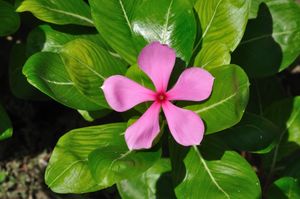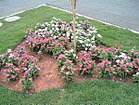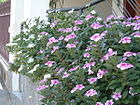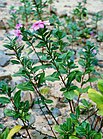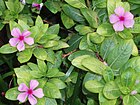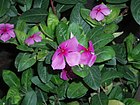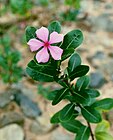Note: This is a project under development. The articles on this wiki are just being initiated and broadly incomplete. You can Help creating new pages.
Catharanthus roseus - Sada Bahar
Catharanthus roseus is a genus of flowering plant in the family Apocynaceae. It is native and endemic to Madagascar, but grown elsewhere as an ornamental and medicinal plant, It is a source of the drugs vincristine and vinblastine, used to treat cancer.
Contents
- 1 Uses
- 2 Parts Used
- 3 Chemical Composition
- 4 Common names
- 5 Properties
- 6 Habit
- 7 Identification
- 8 List of Ayurvedic medicine in which the herb is used
- 9 Where to get the saplings
- 10 Mode of Propagation
- 11 How to plant/cultivate
- 12 Commonly seen growing in areas
- 13 Photo Gallery
- 14 References
- 15 External Links
Uses
Blood pressure, Lung cancer, Leukaemia, Dysentery, Diarrhoea, Hodgkin’s lymphoma, Diarrhea, Bleeding hemorrhoids[1]
Parts Used
Chemical Composition
Indole, Indoline alkaloids, Ajmalicine, Lochnerine, Serpentine.[2]
Common names
| Language | Common name |
|---|---|
| Kannada | Nitypushpa |
| Hindi | Sadabahar |
| Malayalam | Shavam Naari |
| Tamil | NA |
| Telugu | NA |
| Marathi | NA |
| Gujarathi | NA |
| Punjabi | NA |
| Kashmiri | NA |
| Sanskrit | NA |
| English | Periwinkle, Madagascar periwinkle |
Properties
Reference: Dravya - Substance, Rasa - Taste, Guna - Qualities, Veerya - Potency, Vipaka - Post-digesion effect, Karma - Pharmacological activity, Prabhava - Therepeutics.
Dravya
Rasa
Tikta (Bitter), Kashaya (Astringent)
Guna
Laghu (Light), Ruksha (Dry), Tikshna (Sharp)
Veerya
Ushna (Hot)
Vipaka
Katu (Pungent)
Karma
Kapha, Vata
Prabhava
Habit
Identification
Leaf
| Kind | Shape | Feature |
|---|---|---|
| Simple | Opposite | The leaves are lobed or unlobed but not separated into leaflets |
Flower
| Type | Size | Color and composition | Stamen | More information |
|---|---|---|---|---|
| Unisexual | 2-4cm long | Pink to red, white | 5 | Flowers Season is June - August and the flower is radially symmetrical |
Fruit
| Type | Size | Mass | Appearance | Seeds | More information |
|---|---|---|---|---|---|
| General | 10–50 mm | The fruit is dry and splits open when ripe | - | {{{6}}} |
Other features
List of Ayurvedic medicine in which the herb is used
Where to get the saplings
Mode of Propagation
How to plant/cultivate
Vinca or Periwinkle will grow in range of light conditions, from full sun to shade. They will do well in average soils.[4]
Commonly seen growing in areas
Ornamental plant in gardens, Under trees and bushes, Parks and cemeteries.
Photo Gallery
References
- ↑ Karnataka Medicinal Plants Volume - 2 by Dr.M. R. Gurudeva, Page No. 200
- ↑ Chemical constituents
- ↑ Plant desription
- ↑ How to Grow Vinca
External Links
- Ayurvedic Herbs known to be helpful to treat Blood pressure
- Ayurvedic Herbs known to be helpful to treat Lung cancer
- Ayurvedic Herbs known to be helpful to treat Leukaemia
- Ayurvedic Herbs known to be helpful to treat Dysentery
- Ayurvedic Herbs known to be helpful to treat Diarrhoea
- Ayurvedic Herbs known to be helpful to treat Hodgkin’s lymphoma
- Ayurvedic Herbs known to be helpful to treat Diarrhea
- Ayurvedic Herbs known to be helpful to treat Bleeding hemorrhoids
- Herbs with Leaves used in medicine
- Herbs with Flowers used in medicine
- Herbs with common name in Kannada
- Herbs with common name in Hindi
- Herbs with common name in Malayalam
- Herbs with common name in English
- Habit - Ornamental herb
- Index of Plants which can be propagated by Seeds
- Index of Plants which can be propagated by Cuttings
- Herbs that are commonly seen in the region of Ornamental plant in gardens
- Herbs that are commonly seen in the region of Under trees and bushes
- Herbs that are commonly seen in the region of Parks and cemeteries
- Herbs
- Ayurvedic herbs that don't have seed photos
- Apocynaceae
